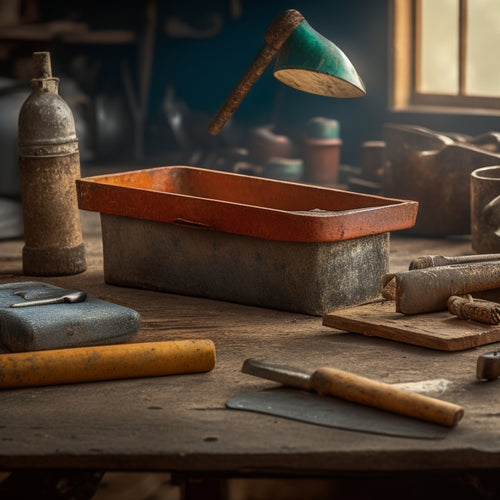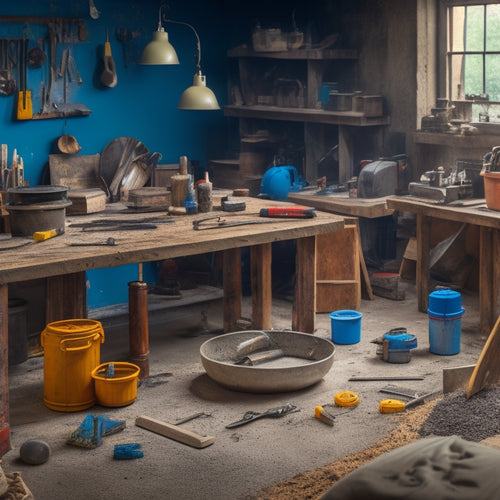
What Tools Do I Need for Concrete Restoration
Share
To tackle a concrete restoration project, you'll need a range of tools, including essential safety gear like hard hats and respirators, cleaning and preparation equipment like pressure washers and scrapers, concrete grinding machines, edging and corner tools like chisels and radius edge tools, polishing and refining instruments, sealing and coating tools, measuring and testing devices, and miscellaneous support tools. From blades and grinders to polishers and safety gear, having the right tools is vital for a successful restoration. As you move forward, you'll discover the specifics of each tool and how they work together to achieve a flawless finish.
Key Takeaways
• Essential safety gear includes hard hats, safety glasses, and respirators to protect workers from harm during concrete restoration.
• Cleaning and prepping tools like pressure washers, scrapers, and chemical cleaners are necessary for surface preparation.
• Concrete grinding equipment, such as walk-behind, ride-on, or handheld grinders, is used to smooth and refine surfaces.
• Edging and corner tools, including chisels, edger blades, and radius edge tools, help create smooth, rounded corners and edges.
• Polishing and refining tools, like grinders, polishers, and abrasives, are used to remove imperfections and achieve a high-gloss finish.
Essential Safety Gear
Wearing essential safety gear, such as hard hats, safety glasses, and respirators, is crucial when working with concrete to protect yourself from hazardous materials and debris.
You'll be exposed to dust, chemicals, and heavy objects that can cause serious injury if you're not properly equipped. As you begin your concrete restoration project, make sure you have the right personal protective equipment (PPE) to safeguard your health and well-being.
Safety protocols should be your top priority, and that starts with wearing the correct gear. Hard hats will protect your head from falling objects, while safety glasses will shield your eyes from flying debris. Respirators will prevent you from inhaling harmful dust and chemicals.
Don't take any chances - always wear your PPE correctly and consistently. By following these safety protocols, you'll be able to focus on the task at hand, knowing you're protected from harm.
Cleaning and Prepping Tools
You'll need a variety of cleaning and prepping tools to remove dirt, grime, and old coatings from the concrete surface, allowing for a strong bond between the old and new materials. This step is vital in concrete restoration, as it guarantees a solid foundation for the new coating or overlay.
In order to achieve proper surface preparation, you'll require tools that can effectively remove contaminants and old coatings.
Some essential cleaning and prepping tools include:
-
Pressure washers to blast away dirt and grime
-
Scrapers and wire brushes to remove old coatings and roughen the surface
-
Chemical cleaners and degreasers to dissolve and remove oil-based contaminants
Concrete Grinding Equipment
With the surface clean and prepared, it's time to utilize concrete grinding equipment to further refine the surface, achieving the necessary texture and profile for ideal bonding.
You'll need a grinder that can handle the specific demands of your project, whether it's a walk-behind, ride-on, or handheld model. Consider the type of grinding you'll be doing most often, as well as the size and scope of your projects, to choose the right equipment.
When it comes to grinding techniques, it's important to work in a systematic and controlled manner to avoid creating scratches or swirl marks. Start with coarse grits and progressively move to finer ones to achieve the desired finish.
Regular equipment maintenance is also vital to guarantee peak performance and extend the life of your grinder. Make sure to follow the manufacturer's guidelines for maintenance, including cleaning and replacing worn or damaged parts.
Edging and Corner Tools
When working on concrete restoration projects, you'll need to address the critical areas where walls meet floors or surfaces intersect.
That's where edging and corner tools come in, allowing you to achieve precise, professional results.
You'll want to familiarize yourself with corner chisel options, edger blade types, and radius edge tools to guarantee a flawless finish.
Corner Chisel Options
Two essential corner chisel options for concrete restoration projects are the flat-edged chisel and the pointed-edged chisel, each designed for specific tasks in edging and corner work.
The flat-edged chisel is ideal for removing old coatings, cleaning corners, and creating a smooth surface for new coatings. On the other hand, the pointed-edged chisel is perfect for removing concrete, creating a V-groove, and preparing the surface for repair compounds.
When selecting corner chisel materials, consider the type of concrete you're working with and the level of wear and tear the tool will endure. For example, a high-carbon steel chisel may be suitable for most concrete restoration projects, but a tungsten carbide-tipped chisel may be necessary for more aggressive corner chisel techniques.
Some key considerations when choosing a corner chisel include:
-
The angle of the chisel edge: A steeper angle can help with more aggressive removal, while a shallower angle is better for finer work.
-
The handle material and grip: A comfortable, non-slip grip can reduce fatigue and improve control.
-
The chisel's weight and balance: A well-balanced chisel can help you work more efficiently and accurately.
Edger Blade Types
Your edger blade selection plays an essential role in achieving clean, precise edges and corners in concrete restoration projects. You'll need to choose the right edger blade type to suit your specific project requirements.
Edger blade materials vary, with options including steel, carbide-tipped, and diamond-coated blades. Steel blades are suitable for light to moderate concrete restoration, while carbide-tipped blades offer increased durability and are ideal for heavier-duty projects. Diamond-coated blades are the most aggressive and provide the highest level of precision, making them perfect for intricate edge work.
Edger blade sizes also play an important role, with common sizes ranging from 4 to 12 inches. Smaller blades are ideal for tight spaces and corners, while larger blades are better suited for open areas and straight edges. You may need to use a combination of blade sizes to achieve the desired results.
When selecting an edger blade, consider the type of concrete, the level of wear, and the desired finish. By choosing the right edger blade type and size, you'll be able to achieve professional-grade results and guarantee a successful concrete restoration project.
Radius Edge Tools
Radius edge tools, designed to tackle curved and angular edges, offer a precision-driven solution for creating smooth, rounded corners and edges in concrete restoration projects.
As you work on radius edge applications, you'll appreciate the versatility and precision these tools provide. When selecting radius edge materials, consider the specific requirements of your project, including the type of concrete, edge profile, and desired finish.
To achieve professional-looking results, you'll need a range of radius edge tools, including:
-
Edge profilers: For shaping and refining edges to the desired radius
-
Edge grinders: For smoothing and polishing edges to a high gloss
-
Edge polishers: For applying a final, high-gloss finish to edges
Polishing and Refining Tools
When you're working on concrete restoration, you'll need the right polishing and refining tools to achieve a high-gloss finish.
You'll have to choose from a range of polishing equipment options, each suited to specific tasks and surface types.
From grinding to honing, you'll need to select the tools that will best help you refine the concrete's surface to perfection.
Polishing Equipment Options
You'll need to select from a range of polishing equipment options, including grinders, polishers, and abrasives, to achieve the desired level of refinement for your concrete restoration project. The type of equipment you choose will depend on the specific polishing techniques you're using and the surface finishes you're aiming to achieve. For example, you may need a high-speed grinder for aggressive polishing or a low-speed polisher for finer refinement.
When selecting polishing equipment, consider the following factors:
- The type of concrete you're working with (e.g., new, old, or damaged)
- The level of refinement required (e.g., high-gloss, matte, or satin finish)
- The size and shape of the area to be polished
Some popular polishing equipment options include:
- Ride-on or walk-behind grinders for large areas
- Hand-held grinders and polishers for smaller areas or detail work
- Diamond abrasives in various grits for progressive polishing and refinement
Grinding and Honing Tools
With your polishing equipment selected, it's time to focus on the grinding and honing tools that will help you achieve the desired level of refinement in your concrete restoration project.
These tools are essential for removing imperfections, scratches, and unevenness, preparing the surface for the final polishing stages. You'll need to choose the right grinding techniques and honing methods to suit your project's specific requirements.
For grinding, you'll need a range of diamond-grit tools, including metal-bonded diamonds, resin-bonded diamonds, and polyurethane tools. These tools will help you remove surface imperfections, old coatings, and unevenness.
Honing methods, on the other hand, involve using specialized tools with finer grits to refine the surface, removing scratches and creating a high-gloss finish. You may also need to use connecting tools, such as terrazzo or concrete grinders, to bridge the gap between grinding and honing.
Sealing and Coating Tools
Sealing and coating tools are essential for applying protective barriers to restored concrete surfaces, and your arsenal should include a range of specialized equipment. These tools enable you to effectively apply sealants and coatings, guaranteeing a durable and long-lasting finish.
When it comes to sealant application, you'll need tools that can handle various coating techniques, such as rolling, brushing, or spraying.
Some essential tools for sealing and coating include:
-
Lambswool applicators: ideal for applying sealants to large, flat areas
-
Microfiber rollers: great for achieving a smooth, even finish
-
HVLP sprayers: perfect for applying coatings to intricate or hard-to-reach areas
With the right sealing and coating tools, you'll be able to achieve a professional-looking finish that protects your restored concrete surface from the elements.
Remember to choose tools that are compatible with the specific sealant or coating you're using, and always follow the manufacturer's instructions for application and safety precautions.
Measuring and Testing Devices
Accurate measurements and test results are essential in concrete restoration, and that's where measuring and testing devices come into play. These devices help you diagnose issues, monitor progress, and guarantee compliance with project specifications.
By employing precise measuring techniques, you can collect data on concrete thickness, surface roughness, and crack width, among other parameters. Using advanced testing methods, such as ultrasonic testing or impact-echo testing, allows you to non-destructively evaluate the internal condition of the concrete.
Some essential measuring and testing devices for concrete restoration include concrete test hammers, Schmidt hammers, and rebound hammers, which assist in assessing concrete strength and hardness. You'll also need devices like surface roughness testers, crack width gauges, and ultrasonic thickness gauges to measure surface characteristics and detect defects.
Additionally, consider investing in devices that can detect moisture, pH levels, or other environmental factors that may impact the restoration process. By incorporating these measuring and testing devices into your toolkit, you'll be well-equipped to collect accurate data, make informed decisions, and guarantee successful concrete restoration projects.
Miscellaneous Support Tools
You'll also need a range of miscellaneous support tools to facilitate efficient and effective concrete restoration, from safety gear like respirators and gloves to utility accessories like mixing buckets and trowels. These tools may not be directly involved in the restoration process, but they play an essential role in supporting your work.
For instance, having the right mixing buckets and trowels can greatly impact the quality of your concrete mix, which in turn affects the final outcome of your restoration project. Additionally, adopting proper mixing techniques and curing methods can make all the difference in achieving the desired results.
Some other essential miscellaneous support tools to take into account include:
-
Cleaning supplies, such as brooms, mops, and solvents, to maintain a clean and safe work environment
-
Storage containers and shelving units to keep your tools and materials organized
-
Measuring cups and scales to accurately measure and mix your concrete ingredients
Frequently Asked Questions
Can I Rent Concrete Restoration Tools Instead of Buying Them?
You can rent concrete restoration tools instead of buying them, weighing tool rental benefits like reduced upfront costs against the cost comparison of frequent rental fees versus one-time purchases.
How Do I Dispose of Concrete Dust and Debris Safely?
As you navigate the concrete jungle, remember the beast of dust and debris lurking beneath; you must tame it with caution, using HEPA-filtered vacuums, sealed bags, and designated landfills for safe disposal of concrete dust, protecting both yourself and the environment.
What Kind of Training Do I Need for Concrete Restoration?
You'll need to invest in certification programs and hands-on workshops to develop the necessary skills for concrete restoration, ensuring you're well-versed in industry standards and best practices to tackle projects with confidence.
Can I Use Concrete Restoration Tools on Newly Poured Concrete?
When working with new concrete applications, you'll find that not all restoration tools are compatible, so you'll need to carefully select tools designed for new concrete, ensuring they won't damage the fresh surface or compromise its integrity.
How Do I Maintain and Store My Concrete Restoration Tools?
You'll prolong the life of your concrete restoration tools by implementing a tool organization system and maintenance schedule, ensuring they're clean, dry, and stored properly to prevent rust and damage.
Conclusion
You've gathered the essential safety gear to protect yourself.
You have the cleaning and prepping tools to prep the surface.
The concrete grinding equipment is ready to remove imperfections.
You possess edging and corner tools to navigate tight spaces.
Polishing and refining tools are on hand to achieve a high-gloss finish.
The sealing and coating tools will help protect the concrete.
You have measuring and testing devices to guarantee accuracy.
Lastly, you have miscellaneous support tools to facilitate the process.
Now, you're fully equipped to tackle any concrete restoration project that comes your way.
Related Posts
-

Smart Guide to Buying Used Concrete Hand Tools
You're about to buy used concrete hand tools, and you need to get it right. Dedicate time to identify the tools you n...
-

Free Design Tools for Concrete House Planning
You can kick-start your concrete house planning project without breaking the bank, as there are several free design t...
-

Budget-Friendly Tools for DIY Decorative Concrete Profiling
You can achieve professional-grade decorative concrete results on a budget by investing in the right combination of e...


